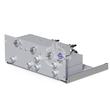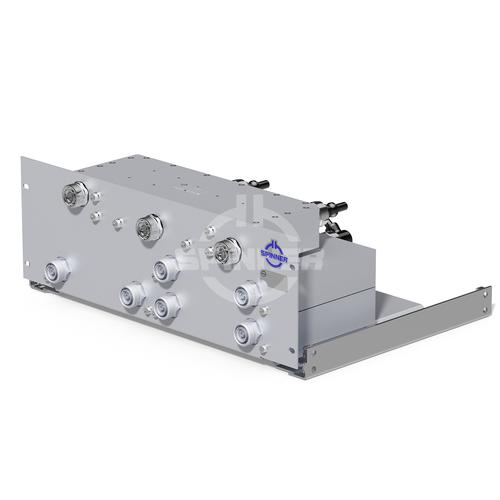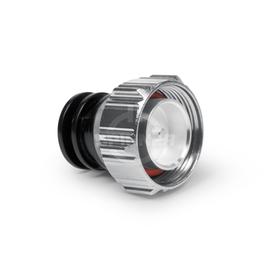SPINNER Combining Units for best radio frequency networks performance
Combining units are essential components in radio frequency networks, used to merge signals from multiple sources or split signals into multiple paths while maintaining signal integrity. All combiners work in bi-directional mode and can therefore be used to combine and split the transmitted and received signals.
The 6 : 3 Combining system 1800/ 2100 MHz 7-16 female guarantees excellent, lossless mobile communication quality for use in in-building distributed antenna systems (DAS) or on mobile communication base stations outdoors.
An advanced multiband combining systems manages multiple bands and signals, providing an all-in-one solution for complex network setups. A multiband combining system is a comprehensive solution designed to integrate multiple signal bands into a unified system. This type of system allows for the simultaneous handling of signals across different frequency bands, optimizing the use of spectrum and infrastructure. It is especially useful in complex network environments where multiple frequency ranges and operators are in operation, enabling more efficient management of bandwidth and improving overall network performance.
They are typically used in:
- In-building Distributed Antenna Systems (DAS): MCS units are commonly deployed in large buildings, shopping malls, airports, and other indoor spaces. They ensure seamless coverage by combining signals from different operators and frequency bands.
- Outdoor base stations: When deploying base stations in outdoor environments, the MCS adapts to varying antenna placements and frequency requirements.
- Network expansion: As networks grow, the MCS can accommodate additional frequency bands or operators without major modifications.
Critical characteristics are:
- Flexibility: MCS units must be adaptable to changing network needs. Their ability to handle multiple frequency bands and operators ensures scalability.
- Low insertion loss: minimizing signal loss during combining is crucial for maintaining overall network performance.
- High isolation: effective isolation between input ports prevents interference.
- Robust construction: outdoor MCS units withstand environmental conditions (temperature, humidity).
- Easy Installation: plug-and-play design (boxed or 19” rack mounting) simplifies deployment.
Benefits are:
- Scalability: multiband combing system units grow with the network, reducing the need for frequent replacements.
- Cost-effectiveness: shared infrastructure lowers costs for building owners and operators.
- Reduced deployment time: quick installation and adaptability speed up network rollout.
- Future-proof: MCS units accommodate technology upgrades and changing frequency requirements.
SPINNER’s MCS stands out due to its innovative design (boxed or 19” rack mounting), adaptability, and performance. Our products are recommended because they provide a flexible solution for both indoor and outdoor mobile communication networks. Whether enhancing in-building coverage or expanding network capacity, SPINNER’s MCS ensures reliable and future-proof communication.
Outstanding RF characteristics, best possible passive intermodulation and VSWR
The 6 : 3 Combining system 1800/ 2100 MHz 7-16 female enables you to transmit high-frequency signals reliably and flawlessly with optimum protection of your sensitive equipment in a power range up to 200 W (each input port) with maximum passive intermodulation (IM3) of -155 dBc .
The protection class is IP 65.
The port path designation regarding main line and probe is as follows: Port 1, 2, 3, 4, 5, 6: input, Port 7, 8, 9: output
It supports the use of the following frequency bands : 1800, 2100
The 7-16 connector has become the most widely used coaxial connection system for mobile communication systems, due to its excellent mechanical and electrical properties. In order to achieve the industry leading intermodulation performance SPINNER applies silver-plating on all inner and outer conductor parts of the standard connector. As a supporting measure, we use exclusively non-magnetic materials, and we have minimized the number of RF contact points. The connection is especially suited for transmitting medium or high power indoors and outdoors.


